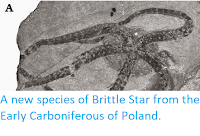Brittle Stars, Ophiuroidea, are five-limbed Echinoderms related to
Starfish and having a similar body-plan. However while the five limbs of the
Starfish are rigid extensions of the central disk, and movement is achieved by
means of tube-feet on the underside of the animal, the limbs of Brittle Stars
are fully articulated and used for locomotion. The fossil record of Brittle
Stars goes back to at least the Early Ordovician, though these Palaeozoic
Brittle Stars have not been extensively studied. Brittle Stars are the largest extant Echinoderm group, with over 2100 described species, 131 of which are placed in a single genus, Ophiacantha, though it is likely that some of these species should be separated out to form new genera.
In a paper published in the journal Zoological Studies on 24 May 2019, Taekjun Lee of the Department of Life Sciences at Korea University, Sabine Stöhr of the Department of Invertebrate Zoology at the Swedish Museum of Natural History, Yeon Jae Bae of the Department of Environmental Science and Ecological Engineering at Korea University, and Sook Shin of the Department of Chemistry Life Science at Sahmyook University, describe a new species of Ophiacantha from Jeju Island, Korea.
The new species is named Ophiacantha scissionis, where 'scissionis' derives from the Latin term scissio, meaning 'split'. The central disks of the observed specimens of this species are 1.3–2.2 mm in diameter, the arms generally less than 10 mm in length. Almost all of the specimens examined had six limbs, rather than five, with the majority having an incomplete central disk, three fully developed arms, and three arms at the same stage of regrowth. This is taken by Lee et al. to indicate that this species reproduces primarily by fission, splitting in two, rather than sexually.
Ophiacantha scissionis in (top) dorsal, and (bottom) ventral views. Lee et al. (2019).
Ophiacantha scissionis was found at depths of between 32.8 and 35.7 m in the waters around Munseom Island, a small island of the southern coast of Jeju Island, Korea. All specimens found were living on the colonial Bryozoan Bantariella bocki. This Bryozoan is currently found from the Bonin Islands of Japan (near Taiwan) in the south, north as far as Jeju Island, but is apparently spreading further north as the climate warms.
Ophiacantha scissionis, regenerating specimens with six arms, stereo-microscopic images. Arrow mark, split points for disk division. Lee et al. (2019).
See also...
Follow Sciency Thoughts on Facebook.









